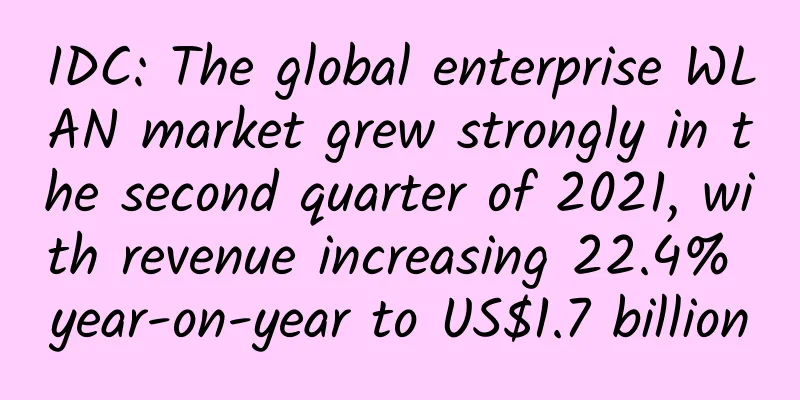IDC: The global enterprise WLAN market grew strongly in the second quarter of 2021, with revenue increasing 22.4% year-on-year to US$1.7 billion

|
According to IDC's quarterly global WLAN market tracking report, the enterprise wireless LAN (WLAN) market maintained strong growth in the second quarter of 2021 (2Q21), with total revenue increasing 22.4% year-on-year to US$1.7 billion. Among them, the consumer WLAN market revenue fell 5.7% year-on-year to US$2.3 billion, and the enterprise and consumer WLAN markets as a whole increased by 4.6% year-on-year. The growth of the enterprise WLAN market builds on strong growth in the first quarter of 2021, when revenue increased 24.6% year-over-year. In the first half of 2021, the market grew 23.5% compared to the first two quarters of 2020, and revenue increased 10.8% compared to the second quarter of 2019, indicating strong demand for enterprise WLAN. Growth in the enterprise WLAN market continues to be driven by the latest Wi-Fi standard, Wi-Fi 6 or 802.11ax. Wi-Fi 6 access points accounted for 56.7% of dependent access point (AP) revenue and 45.0% of shipments. Wi-Fi 5 access points, also known as 802.11ac, accounted for the remaining share. On the other hand, the consumer WLAN market declined 5.7% year-on-year. During the COVID-19 pandemic, the consumer WLAN market achieved strong growth as consumers upgraded their wireless connections at home. The increase was 10.1% compared to the second quarter of 2019, which shows that the market fundamentals remain strong. Wi-Fi 6 products continued to grow in the consumer market, accounting for 24.5% of the total revenue in the consumer market, up from 20.3% in the first quarter of 2021. Wi-Fi 5 still accounts for the majority of revenue and shipments, with a share of 64.1% and 64.0%, respectively. "The enterprise WLAN market showed strong growth in the second quarter of 2021," said Brandon Butler, research manager for network infrastructure at IDC. "From a macro perspective, the global economy continues to recover as the COVID-19 vaccine is rolled out, prompting enterprise organizations to reconsider their enterprise network connectivity needs. WLAN remains one of the most important technologies for enterprises to provide seamless connectivity, enterprise-grade security, management, and assurance." From a geographical perspective, the enterprise WLAN market in all regions of the world showed growth, with the Asian market growing particularly strongly: China grew 57.9% year-on-year, Japan grew 21.9%, the entire Asia-Pacific region (excluding Japan and China) grew 11.1%, and Australia grew 19.6%. The Americas also grew strongly, with the United States growing 14.3%, Canada growing 18.0%, and Latin America growing 19.1%. In Western Europe, the overall market grew by 21.0% year-on-year, with Germany growing by 26.0%. Central and Eastern Europe grew by 18.7% year-on-year, and the Middle East and Africa market grew by 18.6% year-on-year. "Growth was generally seen in all regions of the world in the second quarter of 2021," said Petr Jirovsky, research director of IDC's Worldwide Network Trackers. "While year-over-year growth in the second quarter of 2021 matches the peak of the COVID-19 pandemic in 2020, the sequential growth of many vendors and the growth compared to the second quarter of 2019 indicate that the enterprise WLAN market is growing positively in the future." Market performance of major enterprise-level WLAN vendors:Cisco's enterprise WLAN revenue grew 6.1% year over year in the second quarter of 2021, and it led the market with 38.4%, although this share was lower than 44.3% in the second quarter of 2020. HPE-Aruba grew 16.5% year over year in the quarter, with a market share of 12.2%, down from 12.8% in the same period last year. Ubiquiti's enterprise-level WLAN revenue in the quarter increased 49.7% year-on-year, and its market share also increased from 7.1% in the second quarter of 2020 to 8.7%. Huawei's enterprise WLAN revenue in the quarter increased 72.6% year-on-year, and its market share increased from 6.1% in the same period last year to 8.6%. H3C's enterprise-level WLAN revenue in the quarter increased by 16.2% year-on-year, with a market share of 4.8%. CommScope (formerly Ruckus) saw revenue growth of 18.8% in the quarter, with a market share of 4.8%, which was the same as last year's 4.9%. |
<<: Why does TCP need a three-way handshake? Explain it to you in the most popular words
>>: Customize SD-WAN to meet your needs
Recommend
Operators are enthusiastic about deploying 4.5G: This will affect the commercial use of 5G
In 2017, more and more operators around the world...
Speed up 5G trials! The three major operators are all full of enthusiasm
The third-phase specification release conference ...
Four tips for smart building integrated wiring that you don’t know!
Smart buildings are gradually showing the intelli...
WiFi signal is strong but speed is slow? Here’s how to fix it!
The company's wireless WiFi signal is strong,...
OneWeb launches 182 more internet satellites into orbit
According to foreign media, OneWeb's 36 Inter...
Tencent Cloud Spring Purchase: 2C2G4M cloud server only 40 yuan/year or 200 yuan/3 years, 4C8G10M cloud server only 211 yuan/year
Tencent Cloud launched a Spring Festival shopping...
Kurun: $59/year-2GB/40GB/1TB@500M/China Telecom CN2 GIA/China Unicom CUII9929/China Mobile CMIN2
Kurun is a domestic merchant founded in 2019. Its...
The benefits of 5G technology for education upgrades
With over 250 million students, India has one of ...
CUBECLOUD offers 12% off on all items, and CN2 GIA in Los Angeles and CN2 GIA in Hong Kong are available
CUBECLOUD has launched a promotion for Christmas ...
80VPS: Hong Kong KVM annual payment 330 yuan - dual core/2GB/40G hard disk/3M, Los Angeles large storage machine monthly payment 1200 yuan
80VPS has newly launched the Hong Kong CI data ce...
China Huaxin and Nokia jointly established "Shanghai Nokia Bell"
China Huaxin Post and Telecommunications Economic...
Don’t rush to fight for 5G
Recently, discussions about 5G have been everywhe...
Gartner predicts: Global 5G network infrastructure revenue will grow 39% in 2021
[[416317]] Beijing time, August 9th, according to...
Make the network run autonomously like a driverless car
[51CTO.com original article] Juniper Networks Glo...









